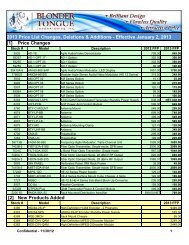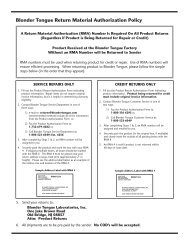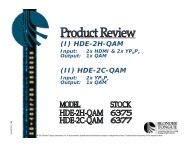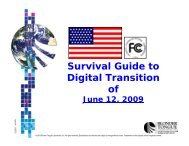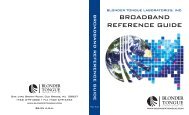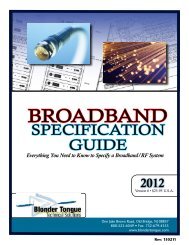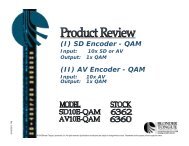Functional Block Diagram - Blonder Tongue Laboratories Inc.
Functional Block Diagram - Blonder Tongue Laboratories Inc.
Functional Block Diagram - Blonder Tongue Laboratories Inc.
You also want an ePaper? Increase the reach of your titles
YUMPU automatically turns print PDFs into web optimized ePapers that Google loves.
Broadband Specification Guide<br />
CATV Terms & Definitions<br />
Heterodyne<br />
The process of mixing (beating) two frequencies together to generate<br />
frequencies of their sum and difference. This process is used for<br />
channel conversion.<br />
1. Combining two carriers to generate a new carrier which may be either<br />
the sum or difference addition of the original frequencies.<br />
2. To shift a carrier frequency to a new frequency by combining it with<br />
another carrier which is locally generated.<br />
Heterodyne Signal Processor<br />
A unit employed in CATV systems to convert a carrier frequency to<br />
an intermediate frequency (IF). The intermediate frequency carrier<br />
may then be filtered, regulated, or otherwise conditioned, and then<br />
heterodyned back to either the original carrier frequency, or to a<br />
completely new carrier frequency.<br />
Highband<br />
The radio spectrum between 174 and 216 megahertz (MHz). Standard<br />
television channels 7 through 13 fall within this spectrum.<br />
High-Split<br />
Two-way cable communication frequency plan, where the diplex filter’s<br />
cross-over frequency is in the high-band. Consists of an incoming<br />
frequency range of 7-186 MHz and an out-going of 222-450 MHz.<br />
Home Run Cabling<br />
Wiring method where each subscriber is fed via a dedicated drop cable.<br />
Horsepower<br />
A unit of mechanical power equivalent to 550 foot-pounds per second,<br />
or to 745.7 Watts.<br />
HRC<br />
Harmonically Related Carriers. Frequencies plan used by some CATV<br />
companies which provides for lower perceived distortion levels in<br />
cascaded amplifiers. HRC channels assignments with the exception of<br />
channels 5 and 6 (.75 MHz higher than standard).<br />
Hum Modulation<br />
Undesired low frequency modulation of a carrier at the frequency of the<br />
source of the interference, or a harmonic of that frequency, usually 60 Hz<br />
or 120 Hz, for example.<br />
Hybrid System<br />
In Cable Television systems, this refers to a system that incorporates<br />
lightwave transmission on optical fibers for a part of the system, and<br />
extends the plant on RF broadband coaxial cables for distribution and<br />
connection to subscribers.<br />
Hydroxylion Absorption<br />
Absorption of optical power in optical fiber due to hydroxyl (OH) ions. This<br />
absorption has to be minimized for low fiber loss.<br />
Hyperband<br />
CATV channels AA thru YY (numeric equivalents -37 thru 61) falling in the<br />
frequency range of 300 to 450 MHz.<br />
IDF<br />
Short for intermediate distribution frame, a cable rack that interconnects<br />
and manages the telecommunications wiring between an MDF and<br />
workstation devices. Cables entering a building run through a centralized<br />
MDF, then each individual IDF and then on to specific workstations. For<br />
example, an enterprise that encompasses a building with several floors<br />
may have one MDF on the first floor and one IDF on each of the floors<br />
that is connected to the MDF.<br />
Index Matching Material<br />
A material, often a liquid or cement, whose refractive index is nearly<br />
equal to an optical element index. Material with an index nearly equal<br />
to that of an optical fiber's core is used in splicing and coupling to reduce<br />
reflections from the fiber end face.<br />
Index Profile<br />
A characteristic of an optical fiber which describes the way its index of<br />
refraction changes with its radius.<br />
Impedance<br />
Circuit characteristic) voltage divided by current). TV distribution has<br />
standardized on 75 ohm and 300 ohm.<br />
Insertion Loss<br />
The loss introduced into a cable or system by the Insertion of a device or<br />
network expressed in decibels. See Loss.<br />
Instructional Television Fixed Service (ITFS)<br />
ITFS is a microwave transmission in the frequency range of 2500-<br />
2686 MHz used by educational entities for distributing programming<br />
employing analog TV transmissions. This band was also referred to as<br />
MMDS and was used by wireless cable operators. The FCC has since<br />
re-designated this band as BRS (Broadband Radio Service) and EBS<br />
(Educational Broadband Service) and has established provisions for<br />
digital transmissions.<br />
Interference<br />
Noise or other disturbances such as spurious signals that, when<br />
introduced to a desired signal, reduce the intelligibility of the information<br />
carried on that signal.<br />
Intermodulation Distortion<br />
The distortion introduced when several or many carriers are passed<br />
through a nonlinear circuit. This includes the spurious signals (beats)<br />
produced as sum and difference additions of the carriers present, and<br />
the transfer or superimposition of modulating information from one<br />
carrier to another.<br />
87



